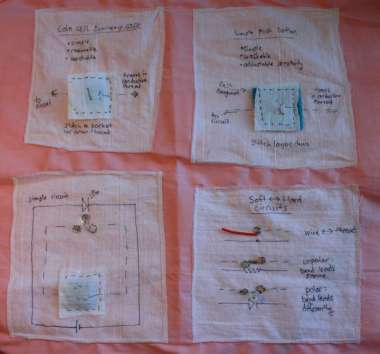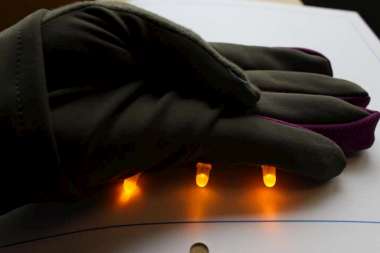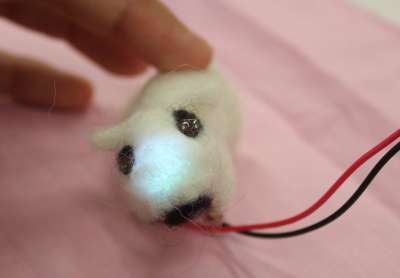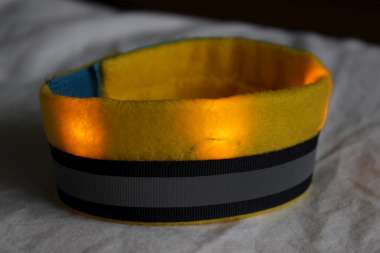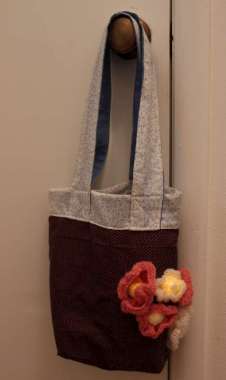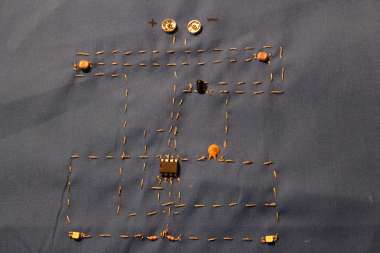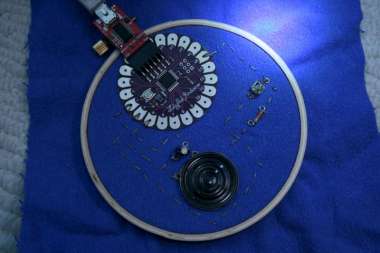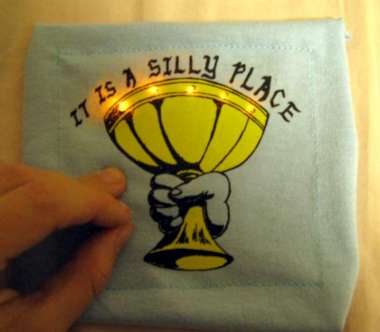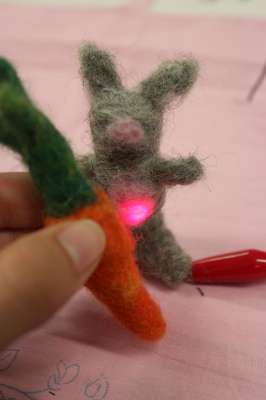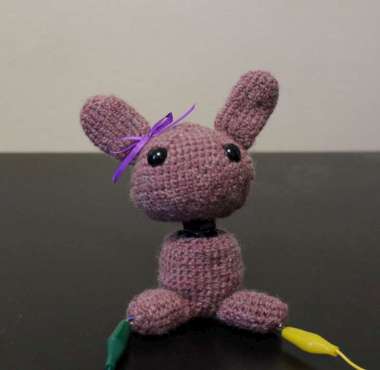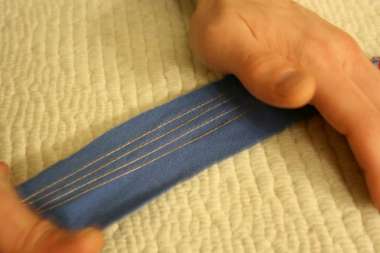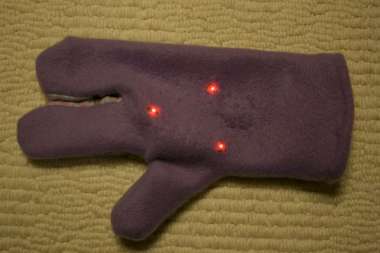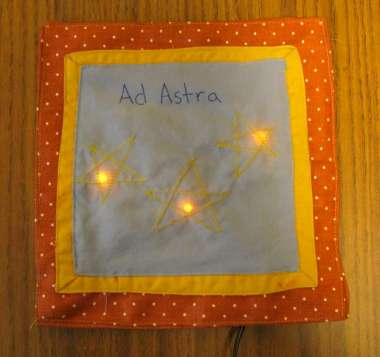For my 21st birthday I got a spool of conductive thread, and for my 22nd birthday I got a Lilypad Arduino and some homemade surface mount LEDs. I've finally started to play with all these awesome toys — below are some of my soft electronic creations.
Sewing & Electronics Tutorials
I've tried to explain some of the basics of sewing with electronics: using components, coin cell battery cases, soft push buttons, and using a multimeter.
I've also written a small tutorial on basic electronics for those who want to get started from scratch.
|
I sewed bike gloves and embellished them with three yellow LEDs that turn on when you press the thumb to the palm. The LEDs are sewing in parallel and powered by a 3V battery. Unfortunately the gloves are actually not very practical for biking, because they are relatively slippery and don't have good ventilation. Oh well! Needle-felting around electronics is relatively easy; thus needle-felting provides a great base for simple circuits. This little sheep's head contains a tricolor LED, 3 fixed resistors, and 3 photosensitive resistors on the eyes and nose. His feet are bare curled wires to attach to a power source: a 9V battery. When you move your hand over the sheep's face, his head changes colors as the resistance of the photoresistors changes the amount of current flowing through each color of the LED. To be visible at night and keep my pants from getting caught in my spokes, I made this glowing, reflective band. The inside is 3 LEDs wired in parallel, with their plastic cases sanded to help diffuse the light. The outside has a strip of reflective iron-on tape from JoAnn and some velcro. The battery slides into a pocket to turn the band on, and can be kept in a separate pocket during the day. TaDa! I knit little flowers, crocheted centers for them, put LEDs inside, and sewed them onto a bag made for that purpose (with the circuit in the lining and the battery accessible from the inside). More photos! This cute little chip is a 555 timer sewn in astable mode into a circuit that makes 2 LEDs blink. The resistors that affect the ratio of on/off and the speed of the switch are both photoresistors, so the project is light-sensitive. Watch a video of it working. This is the first time my lilypad has been sewn to something. Here a light sensor is used to control the tone of a cheap speaker, for an annoying yet cool soft circuit. See a video of it working (turn down your sound a bit first!) My second project was more thought out. I sewed the LEDs to a piece of old sheet in parallel, meaning I could use all 5 with a little 3 volt battery (if they were in series, the battery would not have been able to supply enough voltage). I then created a soft button and a battery holder from another piece of fabric, and sewed this to the first piece of fabric with a sewing machine, creating a cute little circuit which lights up when pushed. I then put this circuit under the pattern from my dorm tshirt (west lagunita, themed spamalag). Ta da! A soft, flexible circuit. |
This needlefelted bunny contains a magnetic switch which is activated when the large carrot, needlefelted around neodynium magnets, is brought near. The bunny's feet end in curls of wire for the + and - terminals. Needlefelting the bunny and his carrots was a ton of fun! Commuting by bicycle is fun, but biking near cars can be intimidating. I made this light-up, reflective and bright cycling vest to help make myself more visible to drivers. The vest back has many feet of pink electroluminescent wire wound through a mesh surrounding a reflective triangle. The front has velcro covered by reflective tape, and the sides are open mesh so it can be worn comfortably in hot weather. I'm taking a really cool class at Stanford called Art and Electronics, taught by Gail Wight. Check out my projects! Trevor made the circuit and arduino program to create a soft stretch sensor for the lilypad. The thread changes resistance as it is stretched. By measuring the resistance change, we were able to change the color of a tri-color LED. This bike glove takes one coin-cell 3V battery to light 3 LEDs when the two fingers contact each other. It will be used for biking in the dark: it will both keep my fingers warm in the 3-fingered bike-glove style and it will serve as a very visible signal if I need to turn or slow down. It was hand-sewn with 4ply conductive thread and surface mount LEDs. My first decent soft electronics project was this square of LED stars. I wasn't really sure what to make, so I'm not too happy with the appearance, but the idea is cool. I sewed most of it on a sewing machine, and hand-stitched the LEDs onto a middle layer of cloth. It snaps into a 9V charger which plugs into the wall just like a cellphone charger would, which is really nifty. |
